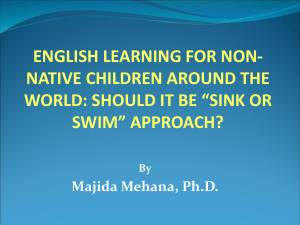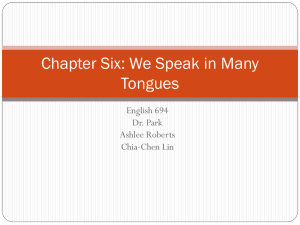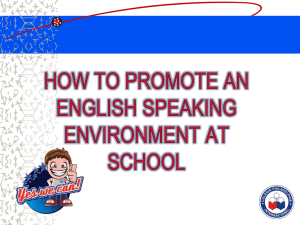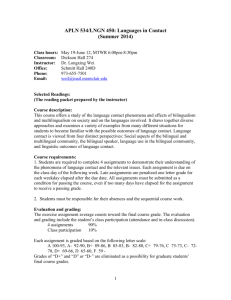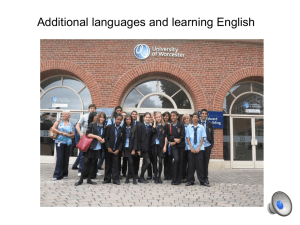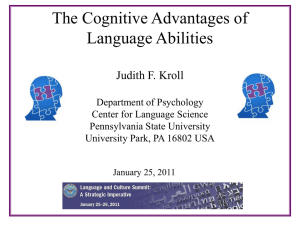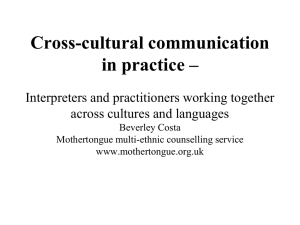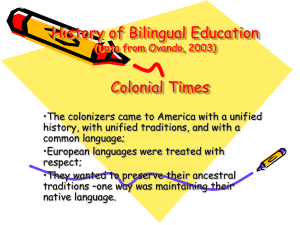Developing bilingual learning strategies in mainstream
advertisement
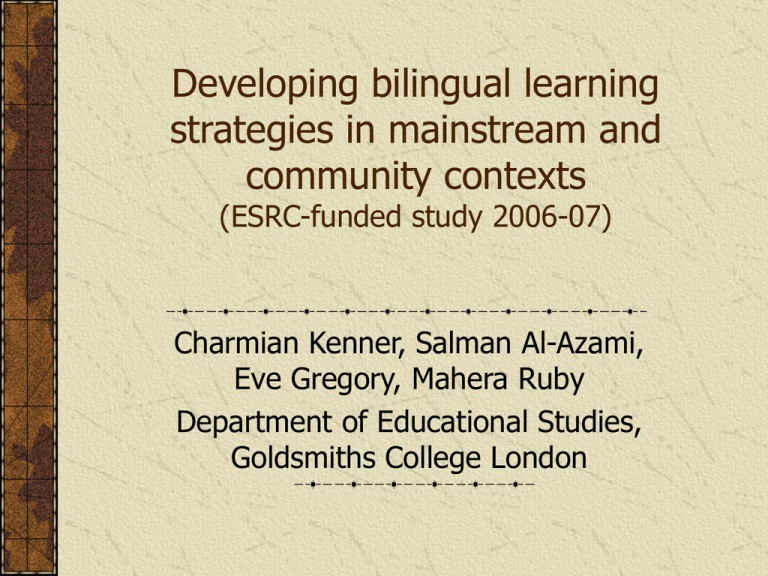
Developing bilingual learning strategies in mainstream and community contexts (ESRC-funded study 2006-07) Charmian Kenner, Salman Al-Azami, Eve Gregory, Mahera Ruby Department of Educational Studies, Goldsmiths College London Bilingual learning: aspects to investigate Transfer of concepts (Cummins, 1984) Translation/interpretation (Creese, 2004) Linking with cultural worlds (Martin-Jones & Saxena, 2003) Increasing knowledge about how language works (Bialystok, 2001) Learner identities (Cummins, 1996; Creese, Bhatt, Bhojani & Martin, 2006) The research context Two primary schools in Tower Hamlets, East London Second/third generation British Bangladeshi children, mostly more fluent in English than Sylheti/Bengali (Bangla) Children also attend community classes in Bengali and/or Arabic Achieving highly at primary school So…is bilingual learning in mainstream school relevant or necessary? The children’s views Participant children School A School B Year 2 (age 7) 4 children Year 2 (age 7) 4 children Year 4 (age 9) 5 children Year 6 (age 11) 4 children Methodology: action research Observe children in community class Plan bilingual tasks in literacy and numeracy for each group, relevant to mainstream curriculum, linking with community class learning Involve community and mainstream teachers in planning Children do task, watch video and comment (stimulated recall) Discuss data with teachers at end-of-term seminar Repeat process in second term Year 6 studying a chora (Bengali poem) Aspects of learning Bengali literary heritage – poem contains metaphor and imagery, also known to children as lullaby Teacher keen to work on comparative literature: compare with lullaby in English Involve parents to understand poem more deeply Use Reciprocal Reading strategy to share findings in group The chora: transliterated and translated Aai aai chad mama Come come uncle moon aai aai chad mama tip die ja Come come uncle moon and touch the forehead chader kopale chad tip die ja Moon come and touch the forehead of the moon dhan banle kuro debo When the rice is made will give you the husk mach katle muro debo When the fish is cut will give you the head kalo gaer dudh debo Will give you the milk of the black cow dudh khabar bati debo Will give you the bowl for the milk chader kopale chad tip die ja Moon come and touch the forehead of the moon Lullaby in English Hush, Little Baby Hush, little baby, don’t say a word, Papa’s gonna buy you a mockingbird. And if that mockingbird don’t sing, Papa’s gonna buy you a diamond ring. And if that diamond ring turns to brass, Papa’s gonna buy you a looking glass. And if that looking glass gets broke, Papa’s gonna buy you a billy goat. And if that billy goat won’t pull, Papa’s gonna buy you a cart and bull. And if that cart and bull fall down, You’ll still be the sweetest little baby in town. Questions for parents Comparison: Venn diagram Reciprocal Reading Sharing findings from parent interviews Each child took a role: (eg questioner, summariser) Children added to or amended information from interviews Clarified their understanding of the chora Took place entirely in English – why? Further development Rhythm of poems, using drums Writing own poem with support from Nasima (Teaching Assistant) Creating bilingual display for school foyer The children’s poem Fruits We get mangoes and jackfruits in summer White berries, black berries, Black grapes, green grapes, Yellow-coloured ripe bananas, Green-coloured tender bananas, Sour berries, sweet berries, Taste very sweet. Conceptual transfer Understanding metaphor and imagery through working in more than one language Not straightforward transfer of ‘similar concept’ Clarification of complex ideas through discussion Translation/interpretation Transliteration as translation Gives children and teacher access to chora Enables children to express ideas in writing Bridge between Sylheti and Standard Bengali Interlingual and intralingual Translation between phonic systems Linking with cultural worlds Learning more about ‘own culture’ Texts include different aspects of children’s experience: Bangla/school/popular culture Venn diagram highlights differences in cultural values / economic contexts Own poem combines knowledge from UK and Bangladesh Learner identities Children actively seeking connection to Bangladesh through culture and language Terms linking to home experience: chad mama Teacher perceiving children as bilingual learners Multiple identities can be expressed at school – otherwise a ‘monolingual space’ Children’s comments on doing maths in Bangla You understand more (if you use both languages) It was different – in English you know what you have to do We'd like to know more about Bangla numbers and operations....how to say it Just liked it because it was different, liked it, liked it You can learn in two different ways And it's our mother tongue and we don't know much about it The crucial role of the mainstream school in supporting language maintenance 2nd and 3rd generation children in Miami are losing their Spanish competence unless they are schooled in Spanish – despite living in a substantial Latino community where Spanish is regularly used in the business and social infrastructure (Eilers, Pearson and Cobo-Lewis, 2006) References Cummins, J. (1984) Language proficiency, bilingualism and academic achievement. Chapter 6 in Bilingualism and Special Education. Clevedon, Avon: Multilingual Matters. Creese, A. (2004) Bilingual teachers in mainstream secondary classrooms: using Turkish for curriculum learning. International Journal of Bilingual Education and Bilingualism 7 (2), 189-203. Martin-Jones, M. and Saxena, M. (2003) Bilingual resources and ‘funds of knowledge’ for teaching and learning in multi-ethnic classrooms in Britain. International Journal of Bilingual Education and Bilingualism 6 (3), 267-282. Bialystok, E. (2001) Bilingualism in Development: Language, Literacy and Cognition. Cambridge: Cambridge University Press. Cummins, J. (1996) Negotiating Identities: Education for Empowerment in a Diverse Society. Ontario, CA: California Association for Bilingual Education. Creese, A., Bhatt, A., Bhojani, N. and Martin, P. (2006) Multicultural, heritage and learner identities in complementary schools. Language and Education 20 (1), 23-43.

